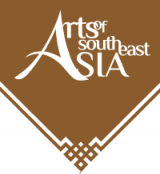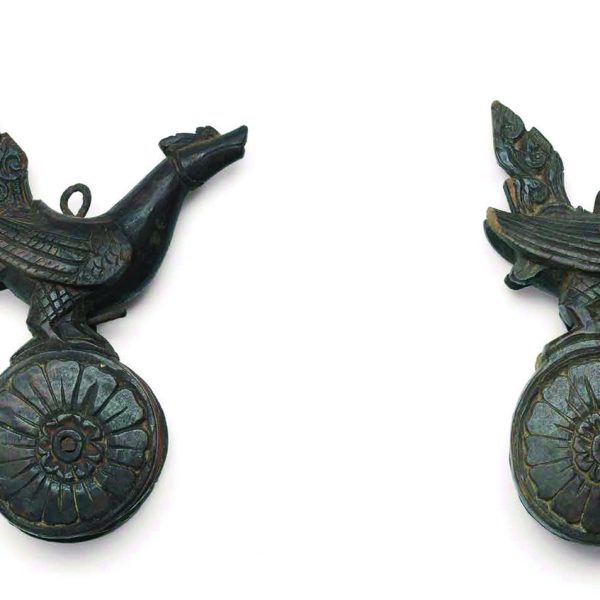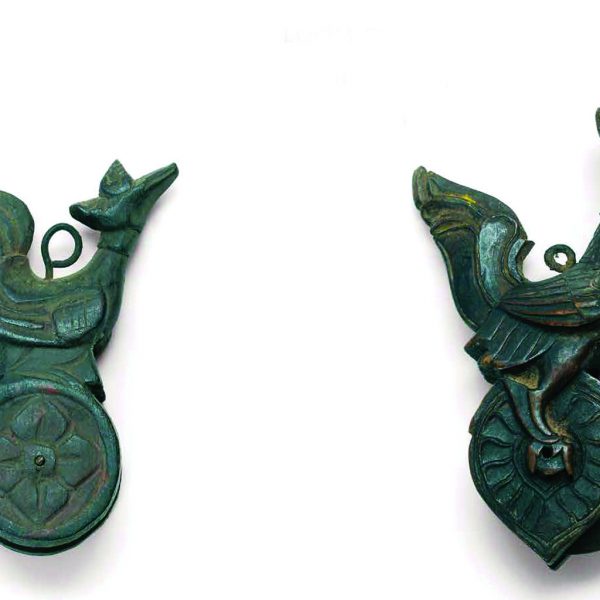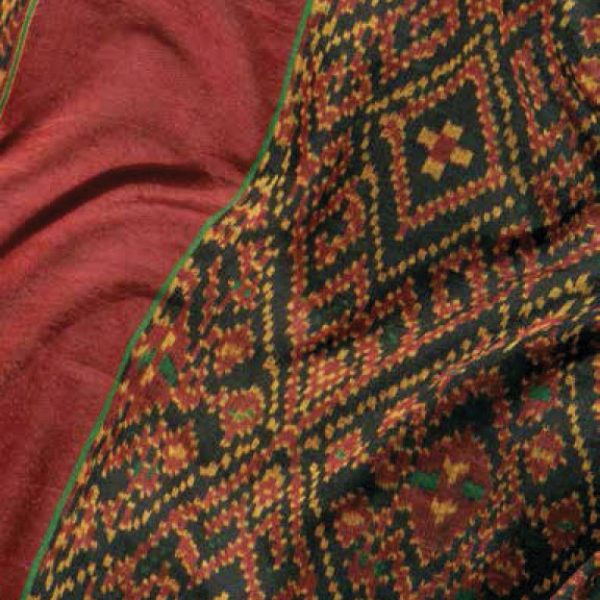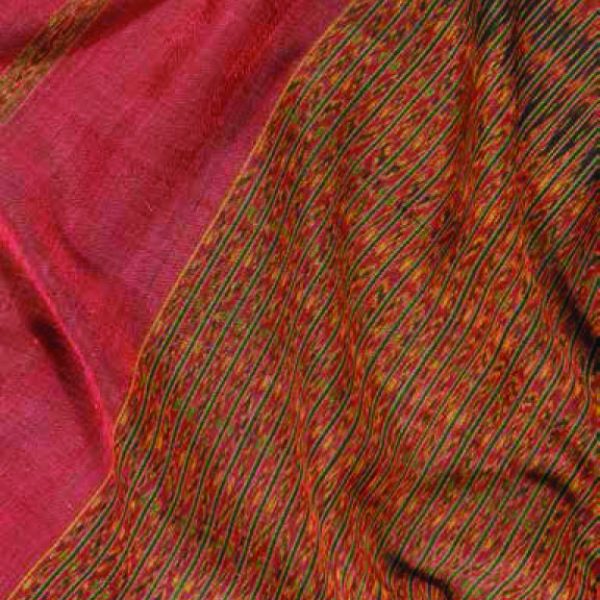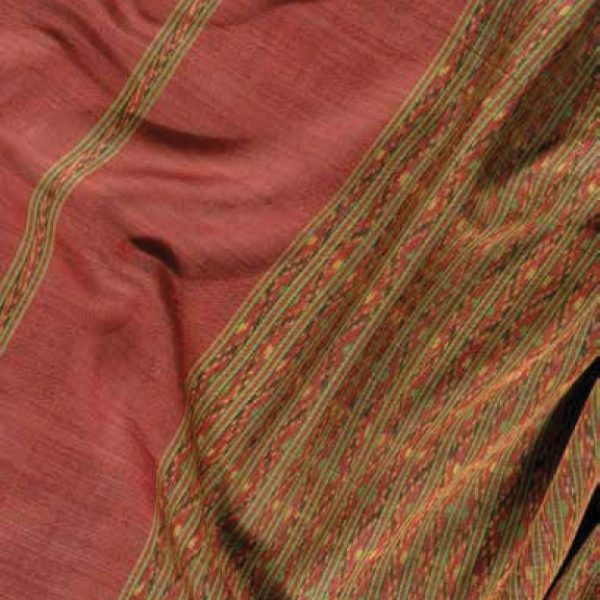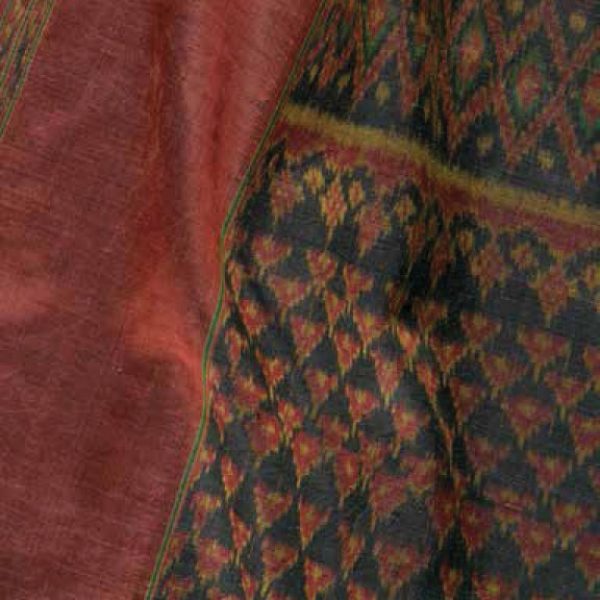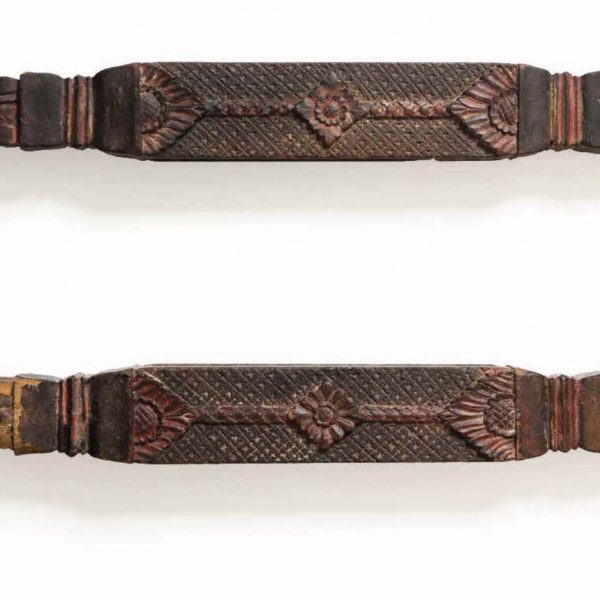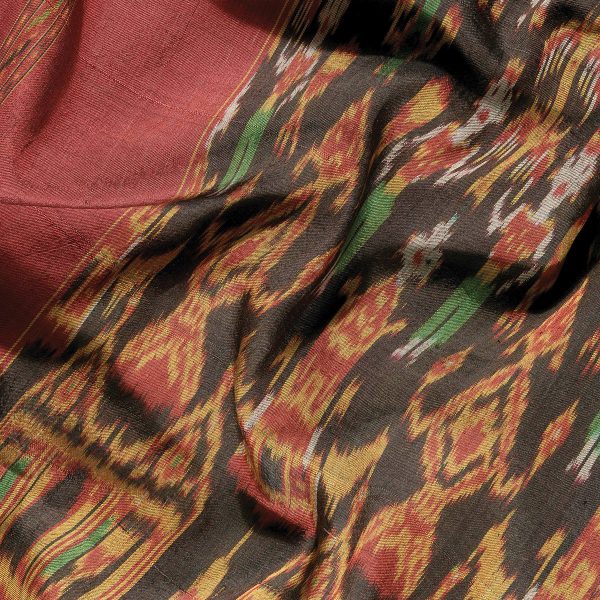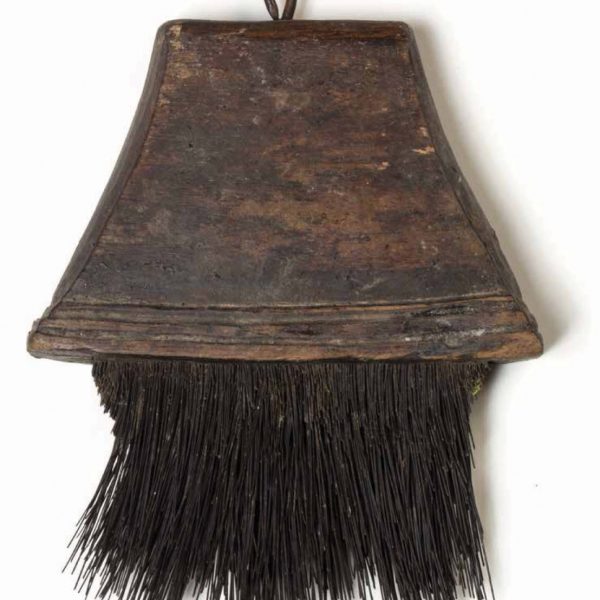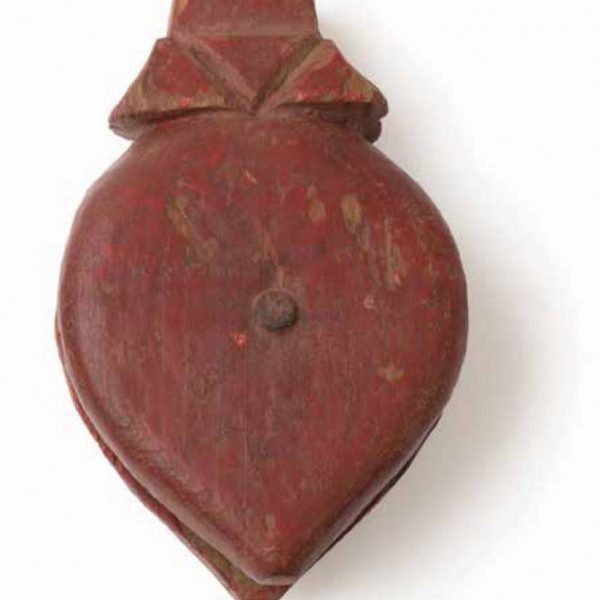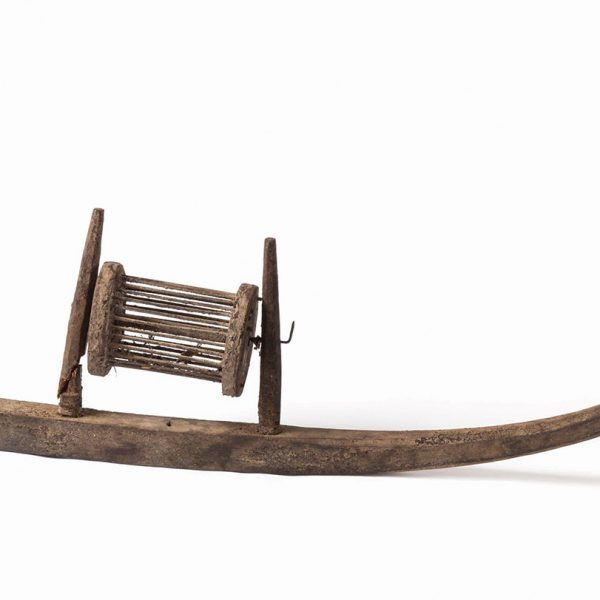Volume 1, Issue 1, March–April 2020.
Khmer Silk
Silk for the Gods
An Exceptional Private Collection
Gillian Green
This essay introduces textiles and weaving implements in the Zelnik collection. Publishing such a large collection of items affords a rare and invaluable resource as the more information and images in the public domain, the more deeply can this important and often overlooked aspect of Khmer culture and history be explored and researched.1 Though there are no existing examples of ancient textiles, the Khmer textile tradition can be traced back many centuries, by examining the dress sculpted on the celebrated sculptures of the Angkorian period – 7th to late 14th century. During this time, it is most likely that the majority of textiles depicted as hip wrappers were not only sourced in India, but also that their styles were adapted from the Indian tradition. The fabric used was probably cotton, indicated by comparison of patterns with those of contemporaneous Indian cotton textiles.
Chinese silk was, however, also known to have reached the Khmer court in the latter part of this period, but pattern analysis suggests those were only used as items of interior décor or for personal accessories. Though the Khmer kingdom was geographically distant from the Indian subcontinent, contact was not as remote as it may seem. Indian merchants had plied maritime trade routes from at least the early first millennium, navigating the Indian Ocean coastline to the Malay Peninsula. Their textiles were among the high value commodities that found their way to Southeast Asian courts. These were traded for highly desired forest products. By the nineteenth century, however, textiles themselves, made in Cambodia, begin to appear in collections affording researchers at least a start point. The most distinctive class of Khmer textiles are handwoven silk weft resist-dyed lengths. Khmer weavers are supremely skilled in their preparation, the variety of their patterns and motifs adding another layer to their fascination.
The inspiration for their evolution is one particular Indian sourced silk textile, the ‘patolu’ (pl. patola) cloth. Patola, woven in the Indian province of Gujarat, are patterned by resist dyeing in both weft and warp. These filmy, colourful prestige textiles were highly desired by Southeast Asian rulers as the larger their collection, the greater their claim of power and prestige. The Khmer term for a weft resist-dyed silk textile worn as an item of dress is sampot hol, where ‘sampot’ is the Khmer language word generically meaning ‘a length of cloth’, and ‘hol’ is the word for resist-dyed weft weaving. Hol is equivalent to the Malay word ‘ikat’ or ‘mat mee’ in the Thai language. What uniquely distinguishes Khmer woven sampot hol from Tai Lao, Malay and Indonesian silk weft ikat is that it is woven in the uneven twill technique resulting in one brighter and one darker side to the cloth, though by definition the pattern itself is identical on both sides.
Khmer sampot hol are prepared in two lengths – about 1 1/2 metres or 3 metres long, both up to a metre wide. These are draped in two ways. The longer length is used for the more traditional style known as sampot hol chawng kbun. where the cloth is wrapped around the hips, the ends drawn through the legs from front to back with the ends secured under the waistband creating a voluminous pants style garment (KA 075/321/331/334/343/379/102). This style was and still is worn by both men and women in Cambodia. The shorter length known as sampot samloy is worn by women as a hip wrapper in a wraparound skirt style (103). This style came into use in the early 20th century in response to the fashion of the Siamese court at that time. The central field, which takes up most of the design field space, is the location of the main area of pattern display. Older examples feature this central field encompassed by one or two borders running down the long sides. The end panels are a plain colour usually containing a few narrow stripes.
Several categories of patterns and motifs are featured in the central field. As seen in the Zelnik collection, one is a lattice structure, oriented diagonally and so forming diamond shapes. These may be filled with flower forms. Other patterns display simple patterns of flowers, stars, or spots laid out in geometric array. Specific patterns are created for wedding sampot hol and those to be used by novice monks on entering the wat. These require patterns based on nak [snake/ dragon] forms or abstracted variations of these. The colour palette of Khmer hol textiles has been remarkably conservative since their first appearance in collections about 150 years ago. The scheme principally features red, yellow and deep indigo with touches of cream, green and blue. Another interesting pattern that features prominently in the Zelnik Collection is much simpler in structure.
It consists of very narrow weft stripes patterned with simple weft resist patterns such as spots, dashes, chevrons or half chevrons. This striped pattern is known as anlunh and the textile itself is sampot hol anlunh (277 detail /339/038/045/054/097). In some examples the stripe is bordered by a warp thread of contrasting colours twisted together. This gives a shimmering effect to the cloth possibly a substitute for a metallic thread. Mon-Khmer communities have for centuries settled in the southern areas of Northeast Thailand (Isaan), particularly in the Surin area. Another community of Khmer, the Kui (Gui), live either side of the Dangkrek Mountains which form the border between Isaan and northern Cambodia. Those Kui living in the Surin area also weave silk weft hol lengths like the Mon-Khmer. Interestingly, the Khmer weavers in Isaan have maintained their uneven twill technique despite being in close contact with Tai-Lao communities of weavers who also weave silk in the weft resist technique, but Tai-Lao weavers employ a plain groundweave so the colour hue is the same on both faces of the cloth. The Khmer in large part retained the traditional colour palette distinctive of weavers in Cambodia itself.
The Khmer hol anlunh weft stripe hol pattern is characteristic of Surin province in Isaan. Photographic images of textiles with this fine striped pattern dated to the first decade of the 20th century show that Siamese court ladies and upper class Isaan ladies wore hol anlunh (the Tai-Lao version of anlunh is known as ‘lai kan’. Information published at an exhibition of Khmer textiles held by the Museum of the Bank of Thailand, Northern Region Branch Textile in 2009, lists sampot hol anlunh as one pattern of silk textile, albeit the lowest ranking, in a list of six pattern styles commissioned from Cambodian weavers by the Siamese court. It is possible that both traditions, the Khmer hol anlunh and the Tai lai kan are based on the Lao royal court silk hip wrappers which have very fine stripes containing tiny ikat patterns and which are further embellished with rich metallic supplementary weft hem borders. A third style of textile in the Zelnik collection is the sampot lboek. This hip wrapper textile is patterned in a silk supplementary weave with small star-like motifs laid out in a precise array. The silk supplementary weft thread is usually the gold colour of the natural silk and resembles a metallic gold thread seen on textiles imported from India. This technique is a speciality of the weavers in the northwest of Cambodia who still excel in this technique today.
Hol pidan: woven pictorial hangings for Buddhist use
Unique to the Khmer tradition is a handwoven silk weft hol textile called ‘hol pidan’. The word ‘pidan’ has the generic meaning of ‘ceiling’ in Khmer language. A ‘hol pidan’ is a pictorial textile distinguished by its Buddhist elements and motifs created with the hol technique. During the last century, rare images appear in photographs showing hol pidan suspended under the roof of a wat. Donating gifts to the wat in the form of money, material gifts or even labour is a way of earning ‘merit’ for the donor. Painting Buddhist images on the walls or architectural elements of the wat earns merit for the male artist, either monk or layman. This opportunity is denied to women but it seems that creating the same images by weaving pictorial panels and suspending these beneath the roof is a way that women can employ their artistic talents to attain merit. The pictorial elements of hol pidan vary greatly in complexity.
Some supremely gifted Khmer weavers construct a composition with a sequence of elements, each different, illustrating episodes in the Vessantara jataka, or an episode from the life of the Buddha. As each element of the composition is different, requiring specific resist dyeing preparation, this form of hol pidan is extremely challenging and only undertaken by the most accomplished weavers. Other hol pidan are composed of a sequence of 2 or 3 (031/293) and up to 20 repeats of simpler representative motif elements (292/352). Repeat patterning is much easier to achieve technically. There are some 30 pidan in the Zelnik collection. Some are singular examples, others are ‘twins’ and there are sets of ‘triplets’, ‘quadruplets’, and a set of quintuplets – that is 2,3, 4 and 5 hol pidan with almost identical patterns. Sets such as these demonstrate that one weaver prepared the resist dyed threads and wove them on a warp long enough to allow multiple hol pidan of the same pattern. Weaving multiples be they hol pidan or sampot hol on a single warp is the norm for handweavers. Setting up a warp is very time consuming and often additional help is needed, so weaving a number of finished lengths on one warp is economic in time and effort. One particularly interesting pidan (KA 348) has two quite different compositions in the central field.
What is particularly fascinating is that one section is derived from a full-length hol pidan – KA 292 and siblings /305/308/341 and the second from KA 301/ and siblings 084/265/307/311. This combination suggests that the weaver had resist dyed more weft thread than necessary for one pidan length so added it to a second to supplement its length. Research into the origins of hol pidan indicates that their appearance is relatively recent, and coincides with the activities of the French inspired School of Cambodian Arts initiated in the 1920s. The Director, George Groslier, was determined to keep the practice of Khmer handcraft alive by encouraging Khmer craftsmen in silver, jewellery, wood and stone, and women in weaving to make items for innovative purposes beyond court and rural use. Such items became highly collectable mementos for French civil servants stationed in the country as well as the ever-increasing numbers of travellers passing through. The Zelnik collection of ‘single’ hol pidan was acquired “…from [a] French doctor’s family, but also few pieces from the former French governor of Indochina’s family and from two other families [whose] members worked in colonial administration” (personal communication 2016).
Tools of the trade
The Zelnik collection features a wide variety of handweaving implements. Despite the complexity and degree of difficulty of hol weaving, the handcrafted tools used to create them are simple and practical. This applies to pulleys, beaters, warp guides and warp boards, as well as implements required for preparing the silk weft such as reeling wheels and hol tying stands. While the Khmer frame loom is an example of a loom familiar throughout Southeast Asia, it does have distinguishing characteristics. These relate to its large size and the particular placement of the warp board, warp guides and the warp-oriented treadles. The implements in the collection range from rudimentary and undecorated, to highly decorated with relief carving lacquered in black, red and some with flourishes of gold. The examples of undecorated pulleys, reels, warp guides are probably those used by rural weavers far from larger centres where efficacy, not expensive decoration, is valued.
The wheel used to collect the silk threads after winding off the cocoons is supported on a bar which protrudes from an upright supported on a solid foot (4244). Warp guides come in pairs. They are in the form of a square beam with the middle section removed, with one end in the form of a head, usually a nak/dragon, or even a fish, the other its tail. The form can also be a simple beam with decorative finials at each end (2465/2484/4360/4362). Hol preparation employs two identical hol tying stands of a specific form – a triangular base with a pole protruding vertically (2497/2495). The base is carved on the outer surface with designs familiar from bas reliefs as far back as the Angkor period. Operation of the loom requires pairs of pulleys connected to the treadles raising and lowering the heddle shafts as required (2584/2561/2599/4294); shuttles, housing the bobbins with the dyed thread wound round, maybe open boat-shaped forms or maybe made of smoothed bamboo tubes, closed at one end with a nose-cone shaped element; and warp brushes with wooden hand pieces and bristles are used to separate the clingy warp threads. During the 19th century the Siamese court required Cambodian weavers to produce silk weft hol patterned textiles to present to their courtiers. Who the weavers of these textiles were – rural Khmer women or court weavers or both – is not clear.
The sampot hol woven for the Siamese court is distinguished from those for domestic Khmer use by the far more elaborate bands of patterning in the end panels. In the early years of the 20th century, George Groslier persuaded the Cambodian king to release his craftsmen and women into his newly established School of Cambodian Arts, Phnom Penh. Their brief there was very different to that of the court. They could now pass on their skills by creating artefacts for the acquisition of people beyond the confines of the royal court in true entrepreneurial spirit. It is significant that in the 21st century the art of weaving and its related technical skills are being appreciated by the arts agencies in Cambodia tasked with recovering, supporting and maintaining the skills of ‘intangible heritage’ creation into the future.
Gillian Green
Footnotes
1 For more detailed information, illustrations and background on the items listed in this text and on Dr. Zelnik’s collection of Khmer silk, see: Conway, Susan et al. Silk for the Gods – Khmer Silk from the Collection of Dr. Zelnik , Hungarian Southeast Asian Research Institute, 2017
